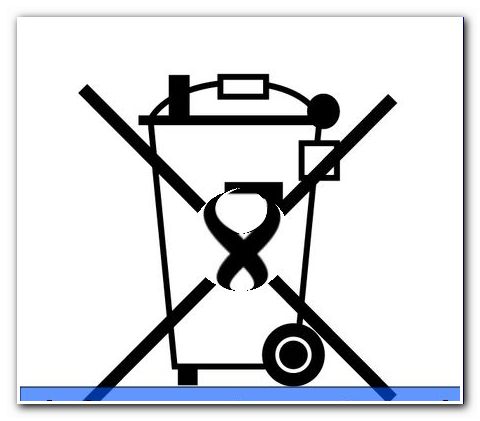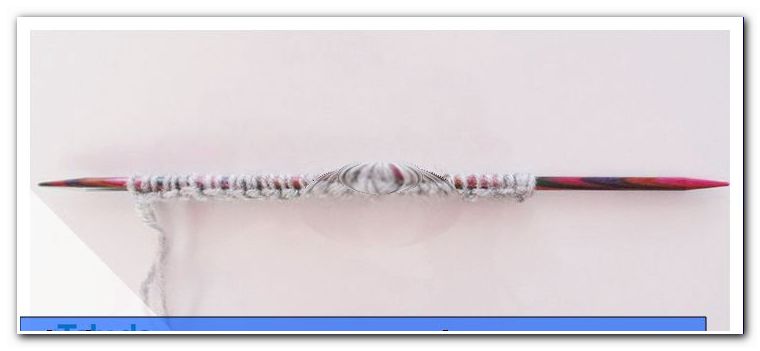Dispose of old car battery - What does it cost? Is there a deposit back?

- Construction of the battery
- Replace the car battery
- Find old battery
- Legal framework for battery withdrawal
- Tips for quick readers
Dangerous but valuable - A battery for a vehicle always has a limited lifespan. With modern materials, this is being extended more and more. Basically, two or three new batteries can be expected in the course of a car's life. Since vehicle batteries contain dangerous ingredients such as lead or sulfuric acid, they must be disposed of professionally. The legislature has set up a deposit system to support the environmentally friendly exchange. We will inform you here how to dispose of an old car battery.
Motorcycles, cars and trucks with internal combustion engines have so-called "lead acid batteries". These serve to store the current produced by the alternator while driving and to supply the starter when starting the car. In addition, they serve as a voltage buffer, so that even at different speeds of the alternator always the right voltage arrives at the respective consumers. Finally, it supplies the on-board electronics of a car even with the engine stopped: light, turn signals, radio, interior lighting are kept in operation for a few hours by the battery, even when the engine is off.
Construction of the battery
A battery or lead-acid battery in a vehicle consists of:
- a plastic housing
- several chambers
- lead plates
- acid
- possibly screw caps
- two poles

As a rule, the acid-resistant plastic housing reliably keeps the acid in its interior throughout the life of the battery. Only in accidents it can jump or break. Otherwise, the manufacturers are now very reliable in this regard.
The chambers indicate how high the voltage a battery can offer. It always applies: Two volts are provided per chamber. A moped battery with three chambers has equivalent to 6 volts, a car battery with 6 chambers always has a 12 volt voltage and truck batteries are usually equipped with 12 chambers, which can deliver accordingly 24 volts. However, the 12 volt voltage is only a theoretical and somewhat outdated value. Today, the normal rated voltage of a battery is always 14.4 volts.
The electric current comes through the so-called "electrolysis process" in the battery. Electricity flows from the generator through the poles into the lead plates and the acid. The acid is charged with free electrons, which can be recalled at any time. So that the battery does not "overcharge" the alternator is equipped with a regulator which stops the charging process when the rated voltage of the battery is reached.
Possible damage
Battery can be damaged by four causes other than by force:
- aging
- deep discharge
- short circuit
- dehydration
The permanent loading and unloading process forms so-called "lead crystals" inside the battery. These sit loosely on the lead plates and can sink into the bottom of the battery over time. If the layer of lead crystals has grown enough to reach the plates, then the cell is shorted. The battery is then unusable in the rule.
The deep discharge occurs when the battery is not charged for several months. This can happen quickly, especially with stored vehicles. A cold outside temperature additionally promotes the deep discharge. However, one should not be fooled: A battery is already considered damaged and deeply discharged when the rated voltage has fallen below 11.8 volts!

Another cause of the deep discharge is when consumers are operated with the engine stopped until the battery is over-discharged. In the past this was often the case with vehicle lighting. A deeply discharged battery is not necessarily lost today, however. For a number of years, the industry has been offering chargers that can be used to repair deep-discharged batteries. The reparability here is still within a narrow range, but a trial is worthwhile in any case. All well-stocked garages, especially those of the well-known chains, offer this service for little money.
A short between the poles is very unusual in itself, but can easily happen when handling tools with the hood open. If, for example, a wrench falls unhappily between the poles, a short circuit can occur. Usually this acknowledges the battery with a bang and the key flies away. However, the battery may have been damaged by it, which is irreparable. If the short circuit remains switched too long, there is a risk of fire and explosion! For this reason, the positive pole of the battery must always be covered.
A battery always needs a certain level of dissolved acid. In older and sometimes still very cheap batteries today, the acid level must still be checked regularly. However, most new batteries are maintenance-free today. If the acid level should be filled, use only distilled water. After filling and recharging, the battery is usually repaired in the event of dehydration.
Replace the car battery
Replacing a battery is actually quite easy. The batteries are firmly screwed in place with a holding device. First, however, the glands are loosened at the poles. Then release the lock until the battery can be removed. All batteries today have a retractable handle, which makes removal considerably easier. When lifting the battery, be careful not to bring it into contact with clothing. It is always very likely that the battery has sweated out some acid. Although this is harmless to the body, after the next wash can be holes in the clothes are frozen.
The battery is ideally stored in a sturdy transport box with carrying handle. If such a box is not available, a plastic bag can make the transport much safer. It is parked in the trunk and secured with straps against falling over.
Before the new battery is installed, some things should be checked. These are
- Bottom plate of the battery holder
- Ground cable
The bottom plate of the battery holder can be very rusty. It is strongly recommended to reseal this rust first by sanding, priming and spray painting, otherwise the sheet crumbles completely sooner or later.
The ground cable is the black cable that connects to the bodywork. It is completely expanded. Then use a wire brush and sandpaper to clean both ends of the cable down to the bare metal. Likewise proceed with the contact point on the bodywork. Thread and contact plate is ground down to the plate before the ground cable is mounted again. After screwing on the ground cable, the point is still sealed with battery poly grease. You have effectively prevented by this measure a so-called "ground fault". This can be harmful for the on-board electronics in the worst case. Most of these errors are expressed by annoying errors: When flashing brake light and turn signals change, strange noises occur or the radio can not be operated.

Now insert the new battery. First screw the battery into place with the lock. Only then put the connections to the poles. Technically, you should not be confused. The positive pole is red and marked with a +, the negative pole is black and with a - marked. Accordingly, the red cable comes to the positive pole and the black ground cable to the negative pole.
It is now extremely important that you reassemble the intended cover of the poles. This is supplied with the battery and affects at least the red positive pole. If you get caught in a general vehicle inspection with a missing coverage at the plus pole, this will cost you 90 Euro penalty and two points in the Central Traffic Register. In addition, if the battery is not properly screwed tight, the penalty is even more expensive.

 Find old battery
Find old battery
The old battery is not household waste and no bulky waste, but must be disposed of professionally. You can do this yourself by moving the battery to a recycling center. You will receive at least one receipt, but usually also a few euros for the valuable materials. A battery contains a few kilograms of lead, which, like any other metal, can be used easily and as often as you like.
 But you can also go to any point of sale where car batteries are purchased. As a rule, you bought a new one before removing the old battery. You will have noticed on the receipt of the item "battery deposit" in the amount of 7.50 euros. After replacement, simply return the old battery to the place where you bought the new battery and you will get back your 7.50 Euro. When buying a new battery, you can also submit the receipt from the recycling center. The deposit will not be charged.
But you can also go to any point of sale where car batteries are purchased. As a rule, you bought a new one before removing the old battery. You will have noticed on the receipt of the item "battery deposit" in the amount of 7.50 euros. After replacement, simply return the old battery to the place where you bought the new battery and you will get back your 7.50 Euro. When buying a new battery, you can also submit the receipt from the recycling center. The deposit will not be charged.
Legal framework for battery withdrawal
Recycling depots and points of sale of new batteries are obliged to take back old batteries. The appropriate case law is "Battery Law" and states in its paragraph 10 that the sellers who sell vehicle batteries to the end user are required to collect the pledge in the amount of 7.50 euros, which you give back when you take back the old battery.
Purely legally, however, the outlets have the option to accept only the batteries they sell themselves. For example, if a supermarket sells car batteries, it does not have to accept any motorcycle or truck batteries. Mostly, the outlets are on this point but accommodating.
The acceptance of batteries must, however, be made at points of sale in "usual household quantities". Hobby used car dealers should therefore always at least before the delivery of spent batteries have bought the appropriate amount of new batteries in the same shop. If this is previously agreed with the business, this also does not hurt. With an adapted, friendly communication can always go out of the way a lot of trouble. However, recycling centers accept batteries in any quantity. However, from a certain point of view, it can also be charged, because for private individuals, the stipulation of the usual amount of households also applies to the public collection agencies. Again, the recycling center should be informed before the delivery of a large item. Roughly over the thumb, we recommend this measure from the delivery of 10 spent batteries.
The disposal of waste batteries should also be done fairly quickly. Old batteries are hazardous waste that must not be stored on private property.
Tips for quick readers
- Always keep the receipt of new batteries
- Submit a receipt from the recycling center when purchasing a new battery
- Do not collect used batteries, but return them immediately
- Never short-circuit batteries
- Before installing the new battery, clean and repair the earth cable
- Before installing the new battery, clean and repair the floor panel of the battery box
- Higher ampere batteries have better cold start performance
- For deep discharged batteries, carry out a repair attempt at a specialist workshop before replacement
- ALWAYS secure the batteries as intended and cover the poles


 Find old battery
Find old battery 

